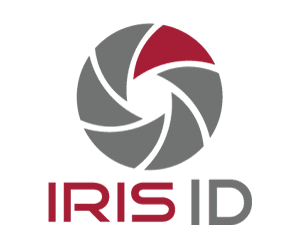
Iris ID has long been one of the leading pioneers of iris-based authentication solutions, particularly in the world of national ID and access control, where its solutions have gained considerable traction in recent years. And with contactless iris-based authentication offering so many compelling applications, it’s only natural that Iris ID would also see success in additional market areas, such as the access control-adjacent area of time and attendance tracking – for which it recently announced a new solution called IrisTime, featuring both iris and facial recognition – and the healthcare sector where contactless biometric solutions offer a particularly strong value proposition, as detailed in last year’s Iris ID White Paper, Biometrics and the Three Elements of Healthcare.
Naturally, that White Paper and the IrisTime solution ended up being key focal points in Iris ID Vice President Mohammed Murad‘s latest interview with FindBiometrics. He and FindBiometrics Editor in Chief Peter Counter also discussed the advantages of multimodality, Iris ID’s handhelds-focused partnership with Telaeris, and some of Iris ID’s major achievements as the company closes out an eventful decade of business.
Read the full FindBiometrics interview with Mohammed Murad, Vice President of Global Sales and Business Development at Iris ID:
Peter Counter, Editor in Chief, FindBiometrics: Iris ID just launched a new time and attendance tracking solution, IrisTime iT100. It’s a biometric timeclock that uses both iris and face recognition for employee time management. My first question is: why should enterprises be upgrading to biometrics when it comes to time and attendance solutions?
Mohammed Murad, Vice President Global Sales and Business Development, Iris ID: First of all, thank you very much for having this conversation. We are always excited to speak with a representative of FindBiometrics. You guys have a great following around the world with the content you produce.
Let’s discuss IrisTime iT100. Iris ID has been in the iris recognition business for 20 years and we are seeing a movement within enterprises at all different levels to manage their workforce. Most of these enterprises have gone through variations of solutions for time and attendance applications. They have used other biometrics, tokens, etc. – and there are always concerns about accuracy, false rejects, contact level, and high administrative costs of lost tokens. We have seen with our previous products, which are focused on the identity management and access control applications, there is a growing interest to deploy that in time and attendance, and we have been successful in doing so at large enterprises.
We believe that the iris recognition business is ready for vertical applications. The idea of having IrisTime as a clock available for an Android platform allows us to be part of an existing ecosystem of applications. We are very excited to say that we have built a product that any of our independent software vendors can take and build an application that is purpose-built for their customer base to support applications focused on time and attendance.
We are already working with major workforce management vendors to have their application run inside the IrisTime iT100 device. We are providing customization and flexibility to fit customer and market needs. We are saying to our customers: our expertise is iris identification and we are giving you a positive and strong authentication technology. We want to build an ecosystem of partners, systems integrators and ISV’s that will develop and deliver application to the organizations.
We are changing the way the timeclocks work today. If you purchase a biometrics timeclock from any vendor, it is a static application that essentially runs in the device with limited capacity to fit your business. IrisTime iT100 is designed so that custom applications can connect to enterprise HR data as an interactive tool for employees to access their information on 401K status, vacation time left, overtime, etc. IrisTime offers a large LCD touch screen so that all that information is graphically pleasing to the eye.
Peter Counter, Editor in Chief, FindBiometrics: That type of flexibility seems like such an amazing advantage in such a wide-ranging market. What industries do you expect to be the most eager adopters of IrisTime?
Mohammed Murad, Vice President Global Sales and Business Development, Iris ID: At this moment, we are going to focus on the workforce management vertical. What we believe any organization looking to manage their workforce would be an adopter of this technology. Early adopters are going to be businesses who have very unique requirements for identity authentication and are struggling with contact base biometrics with lower accuracy.
Peter Counter, Editor in Chief, FindBiometrics: Great. We have been talking a lot about iris recognition obviously – that is your main specialty – but the IrisTime timeclock is a multi-modal device. It does have some facial recognition as well. What is the benefit of having both iris and face biometrics on a timeclock?
Mohammed Murad, Vice President Global Sales and Business Development, Iris ID: We are focusing on convenience and accuracy. IrisTime offers multifactor authentication with the choice of face and iris biometrics. Customers will have a choice to use the device for single or fused modality. It is a multifactor device, which has a very high-quality face camera with very convenient capture distance. We are looking at 50-60 cm away from an individual which is about 20 inches in imperial measurements.
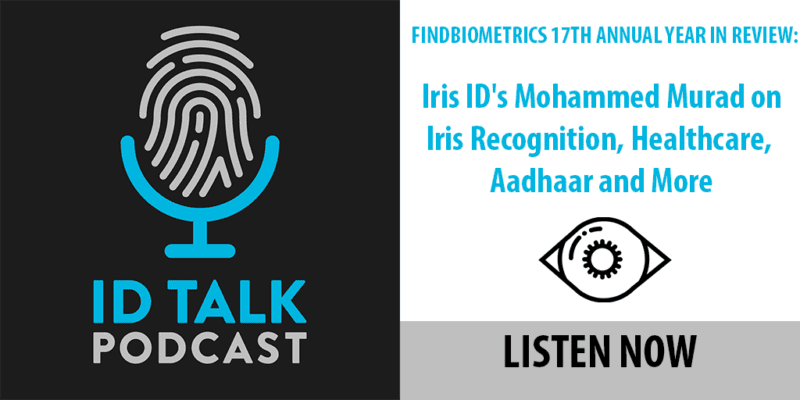
Peter Counter, Editor in Chief, FindBiometrics: IrisTime joins a considerable product line of workforce and access management solutions from Iris ID, and that includes the iCAM M300 biometric handheld which is the subject of your new partnership with Telaeris. How does your partnership with Telaeris enhance the handheld offering?
Mohammed Murad, Vice President Global Sales and Business Development, Iris ID: Most of the time we talk about authenticating at a fixed location to grant access to facilities or approve a transaction. By adding mobility with the handheld iCAM M300, we can conveniently extend authentication while still being tightly integrated to the access control platform. This integration is offered by Telaeris solution. Telaeris has a very strong reputation in the handheld market and product integration with all the major building management systems.
The integration of iCAM M300 with Telaeris XpressEntry and Iris ID IrisAccess platform can extend the authentication beyond a fixed location and additionally offer an accurate identity management platform during emergency for mustering.
Peter Counter, Editor in Chief, FindBiometrics: Sounds like a powerful access paradigm in the workplace. That is really fantastic.
Iris ID also recently announced compatibility with LEAF Access Cards, how does an access card integration affect the overall biometric security system? And what are the benefits of a system like that?
Mohammed Murad, Vice President Global Sales and Business Development, Iris ID: Iris ID products conform to industry standards and LEAF combines the best security protocols and ISO standards with technologies to provide for interoperable solutions. Security through standards is enabling our customers to experience an open and secure world.
Large enterprise customers have taken the initiative to adapt the LEAF standard. So, our integration with LEAF enables our iCAM 7S series, which is an access control mainstay for iris recognition, to write and read the LEAF standard cards that is essentially based on the MiFare DESFire EV1 – EV2 standards.
Your other question about why cards: that’s because many enterprises not only want centralized databases of this information, but they also want the distributed credential capability as well. So, if an employee is moving from one location to another, they don’t need to worry about moving their biometric information to those locations. They just enable the credential for each location. As most enterprises are looking for dual factor authentication with this approach, we can offer biometrics on the cards and satisfy some GDPR requirements. The dual factor authentication offers a strong security protocol.
Peter Counter, Editor in Chief, FindBiometrics: Makes a lot of sense in terms of a decentralized mode of template storage and adds a lot of flexibility, especially with some legacy systems.
Just pivoting to a more focused part of our conversation on healthcare, in September Iris ID published a new white paper titled “Biometrics and the Three Elements of Healthcare”. The three elements that are described in the paper are: access control, manufacturing, and patient ID. One of the things that I think is most interesting is the focus on manufacturing. How can biometrics improve the pharmaceutical manufacturing process?
Mohammed Murad, Vice President Global Sales and Business Development, Iris ID: Iris ID has been involved in multiple areas of the healthcare industry to provide identity authentication applications. The pharmaceutical industry is a very regulated industry where identity authentication for usage of devices and the manufacturing process is extremely important. Iris biometrics can provide enterprise-wide user authentication within the pharmaceutical enterprise for electronic biometric signatures. We have partners integrating Iris ID’s solution with applications enabling operators of pharmaceutical manufacturing pods to use iris biometrics to simply look at a camera to begin operating the pod or sign off on the regulatory required documents. In these environments, operators are fully covered. They may wear masks, gloves, goggles – even hairnets – so it can be very difficult to use any other biometric technology to provide identity authentication. Industry leaders are looking at iris recognition to be part of that manufacturing process.
We believe that accurate, face and contactless individual identity authentication during the manufacturing process is a element for security and convenience.
Peter Counter, Editor in Chief, FindBiometrics: It seems like in terms of the regulations and the safety, the contactless nature of iris just makes sense in that space.
In terms of access control, from a converged access perspective, what kind of biometric is best suited in the healthcare space, and what are your healthcare customers looking for specifically when it comes to access?
Mohammed Murad, Vice President Global Sales and Business Development, Iris ID: The big concern for most healthcare providers is to positively identify a service provider and patient with a contactless technology – while protecting patient data privacy. One simple example is a hospital. If it is using an access control solution for the employees, they are concerned about the contact spread of germs. Our technology is contactless and can work behind objects like glass or goggles. It lends itself very nicely for use in that industry whether it be a hospital, clinic, or lab that requires protection for the employees and data.
Peter Counter, Editor in Chief, FindBiometrics: And lastly on the topic of patient ID we have seen biometrics proposed as patient ID solution for many years now, but it does seem like things are finally starting to gain some momentum on that front. Why is now the time for biometric patient ID?
Mohammed Murad, Vice President Global Sales and Business Development, Iris ID: Utilization of iris biometric patient ID ensures individuals seeking care are properly identified and treated in accordance to their needs. A misidentified patient record can lead to ineffective or dangerous treatments and it can also leave the door open to fraud. Electronic health records and e-prescriptions linked to a person’s iris means no more mixups in the doctor’s office or at the dispensary. What’s more, biometric patient ID enables fast identification when time is of the essence and the person in need of care may be unable to provide documentation. In emergency situations with unconscious, disabled or undocumented patients, a biometric scan can mean the difference between effective treatment and serious medical challenges.
There are financial benefits to iris enabled patient ID as well. A strong foundation of assured identity, which iris provides, prevents financial misappropriation by highlighting insurance fraud and minimizing clerical errors like duplicate files and patient misidentification. Just imagine iris linking patients to their proper prescription, medical history and insurance information. They are sure to receive the proper care with the appropriate benefits along with the peace of mind that their privacy is being protected.
Peter Counter, Editor in Chief, FindBiometrics: That makes a lot of sense and I think that the white paper itself makes a great case for the public safety applications for patient ID as well.
In terms of the white paper being an educational piece, I’m wondering: are there any misconceptions about biometrics in healthcare that you come across regularly?
Mohammed Murad, Vice President Global Sales and Business Development, Iris ID: The biggest question about biometrics is ‘will it work for us’, and privacy issues. We put those to bed by saying that biometrics protect your privacy, so only you – who are present at the time of requesting a service or performing a transaction– can have access to the information. No one else, even if they steal your driver’s license, can get the data if biometrics are being used.
There are misconceptions, but having a biometric-enabled mobile phone in your pocket is making it easier for our industry to educate the public. Biometrics protect your privacy and provide convenience.
Peter Counter, Editor in Chief, FindBiometrics: I definitely agree with you, the consumer biometrics that we have seen proliferate over the past few years has definitely made people much more familiar with biometrics in general and even iris recognition.
On that note, we are entering a new decade, and Iris ID is a long standing player in this industry, as you mentioned at the top of this interview and many of our readers know. So, my question is: what’s next for Iris ID?
Mohammed Murad, Vice President Global Sales and Business Development, Iris ID: Iris ID has a long history of technology innovation. We have many new projects in the pipeline for 2020 and beyond. We continue to provide our solutions to major corporations and governments around the world to solve their identity authentication challenges. Our customers demand the best solutions from Iris ID and we are happy to say we have not disappointed. We see a great future with the application of iris technology in a variety of markets.
We are seeing a strong demand around the world for iris-based solutions. In 2019, we saw double digit growth and forecast similar trends in 2020 onwards.
Peter Counter, Editor in Chief, FindBiometrics: Excellent. Thanks, Mohammed, for taking the time to talk with me today.
Mohammed Murad, Vice President Global Sales and Business Development, Iris ID: Thank you very much.


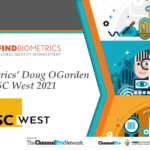
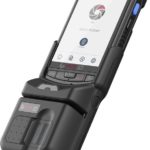



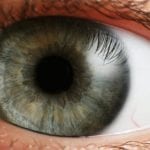
Follow Us